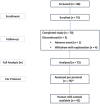Dynamics of human milk oligosaccharides in early lactation and relation with growth and appetitive traits of Filipino breastfed infants
- PMID: 36243744
- PMCID: PMC9569346
- DOI: 10.1038/s41598-022-22244-7
Dynamics of human milk oligosaccharides in early lactation and relation with growth and appetitive traits of Filipino breastfed infants
Abstract
Human milk oligosaccharides play a key role in the maturation of the infant gut microbiome and immune system and are hypothesized to affect growth. This study examined the temporal changes of 24 HMOs and their associations to infant growth and appetitive traits in an exploratory, prospective, observational, study of 41 Filipino mother-infant dyads. Exclusively breastfed, healthy, term infants were enrolled at 21-26 days of age (≈ 0.75 mo) and followed for 6 months. Infant growth measures and appetitive traits were collected at visit 1 (V1) (≈ 0.75 mo), V2 (≈ 1.5 mo), V3 (2.5 mo), V4 (2.75 mo), V5 (4 mo), and V6 (6 mo), while HMOs were measured at V1, V2, V3 and V5. Overall exposure to each HMO was summarized as area under the curve from baseline to 4 months of age and examined in association with each measure of growth at 6 months using linear regression adjusted for maternal age at birth, infant sex, birth weight, and mode of delivery. We saw modest associations between several HMOs and infant growth parameters. Our results suggest that specific HMOs, partly as proxy for milk groups (defined by Secretor and Lewis status), may be associated with head circumference and length, increasing their relevance especially in populations at the lower end of the WHO growth curve. We did not identify the same HMOs associated with infant appetitive traits, indicating that at least in our cohort, changes in appetite were not driving the observed associations between HMOs and growth.Clinical trial registration: NCT03387124.
© 2022. The Author(s).
Conflict of interest statement
Tinu M. Samuel, Mickaël Hartweg, Jowena Lebumfacil, Aristea Binia, Norbert Sprenger are employees of Société des Produits Nestlé S.A. Elvira M. Estorninos, Katherine. B. Buluran, and Rachel. B. Lawenko received funding from Société des Produits Nestlé S.A to conduct the study.
Figures





Similar articles
-
Longitudinal change of selected human milk oligosaccharides and association to infants' growth, an observatory, single center, longitudinal cohort study.PLoS One. 2017 Feb 9;12(2):e0171814. doi: 10.1371/journal.pone.0171814. eCollection 2017. PLoS One. 2017. PMID: 28182762 Free PMC article.
-
Associations between human milk oligosaccharides and infant body composition in the first 6 mo of life.Am J Clin Nutr. 2015 Dec;102(6):1381-8. doi: 10.3945/ajcn.115.115451. Epub 2015 Oct 28. Am J Clin Nutr. 2015. PMID: 26511224 Free PMC article.
-
Human milk oligosaccharides in breast milk and 2-year outcome in preterm infants: An exploratory analysis.Clin Nutr. 2022 Sep;41(9):1896-1905. doi: 10.1016/j.clnu.2022.07.024. Epub 2022 Jul 21. Clin Nutr. 2022. PMID: 35944296
-
Human Milk Oligosaccharides and Immune System Development.Nutrients. 2018 Aug 8;10(8):1038. doi: 10.3390/nu10081038. Nutrients. 2018. PMID: 30096792 Free PMC article. Review.
-
Human Milk Oligosaccharides and Infant Neurodevelopment: A Narrative Review.Nutrients. 2023 Jan 31;15(3):719. doi: 10.3390/nu15030719. Nutrients. 2023. PMID: 36771425 Free PMC article. Review.
Cited by
-
Human Milk Microbiome and Microbiome-Related Products: Potential Modulators of Infant Growth.Nutrients. 2022 Dec 3;14(23):5148. doi: 10.3390/nu14235148. Nutrients. 2022. PMID: 36501178 Free PMC article. Review.
-
Screening competition and cross-feeding interactions during utilization of human milk oligosaccharides by gut microbes.Microbiome Res Rep. 2024 Jan 1;3(1):12. doi: 10.20517/mrr.2023.61. eCollection 2024. Microbiome Res Rep. 2024. PMID: 38455082 Free PMC article.
-
Human milk oligosaccharide composition and associations with growth: results from an observational study in the US.Front Nutr. 2023 Oct 3;10:1239349. doi: 10.3389/fnut.2023.1239349. eCollection 2023. Front Nutr. 2023. PMID: 37854348 Free PMC article.
-
Developmental trajectories of eating behaviors and cross-lagged associations with weight across infancy.Appetite. 2023 Sep 1;188:106978. doi: 10.1016/j.appet.2023.106978. Epub 2023 Jul 24. Appetite. 2023. PMID: 37495177 Free PMC article.
-
Human milk oligosaccharide composition is affected by season and parity and associates with infant gut microbiota in a birth mode dependent manner in a Finnish birth cohort.EBioMedicine. 2024 Jun;104:105182. doi: 10.1016/j.ebiom.2024.105182. Epub 2024 Jun 4. EBioMedicine. 2024. PMID: 38838470 Free PMC article.
References
Publication types
MeSH terms
Substances
Associated data
LinkOut - more resources
Full Text Sources
Medical
Research Materials

